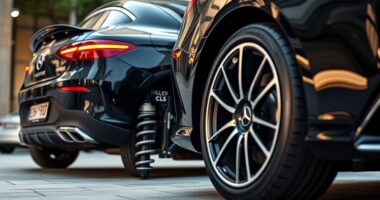You can enhance your Mercedes S-Class and AMG GT with aerodynamic modifications that improve performance, stability, and efficiency. For the S-Class, consider installing OEM or aftermarket kits like front bumpers, diffusers, and side skirts made from lightweight materials such as carbon fiber to reduce drag and increase downforce. The AMG GT benefits from active systems like adjustable spoilers and diffusers that boost high-speed handling. Exploring these options further will help you maximize your vehicle’s aerodynamic potential.
Key Takeaways
- Mercedes offers OEM aerodynamic packages including front bumpers, diffusers, side skirts, and spoilers to enhance airflow and stability.
- The S-Class features underbody panels and active grille shutters to reduce drag and improve fuel efficiency.
- The AMG GT incorporates active spoilers, air dams, and rear diffusers for increased downforce and high-speed handling.
- Custom aftermarket kits like Prior Design and Forza Performance improve aerodynamics with lightweight, durable materials such as carbon fiber.
- Advanced testing methods, including wind tunnel and CFD simulations, optimize aerodynamic modifications for both models.
Enhancing the Mercedes S-Class With Aerodynamic Kits
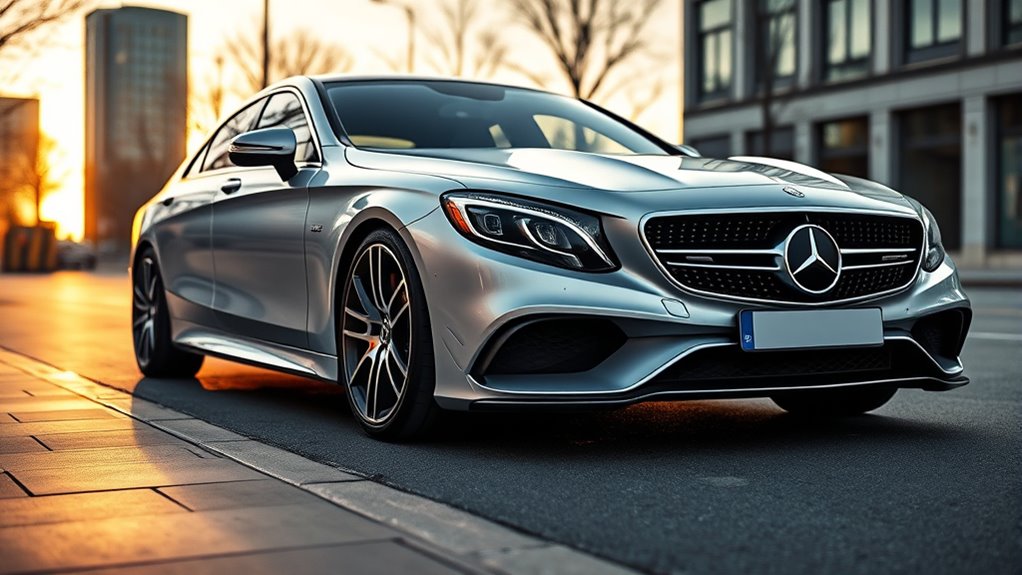
Enhancing the Mercedes S-Class with aerodynamic kits can substantially boost both its appearance and performance. These kits typically include components like front bumpers, lips, and diffusers that improve airflow around your vehicle. By optimizing airflow, you reduce drag and increase downforce, leading to better handling and stability at higher speeds. Materials such as lightweight carbon fiber or fiberglass guarantee these modifications don’t add unnecessary weight. You can choose from various options like the Prior Design PD800s kit for W222 models or Forza Performance Body Kits for W223 models, each offering specific styling and aerodynamic benefits. Installing these kits requires professional expertise to ensure perfect integration with your car’s existing design. With the right aerodynamic kit, your S-Class becomes more dynamic, stylish, and performance-oriented.
Features of AMG GT’s Active Aerodynamic Systems
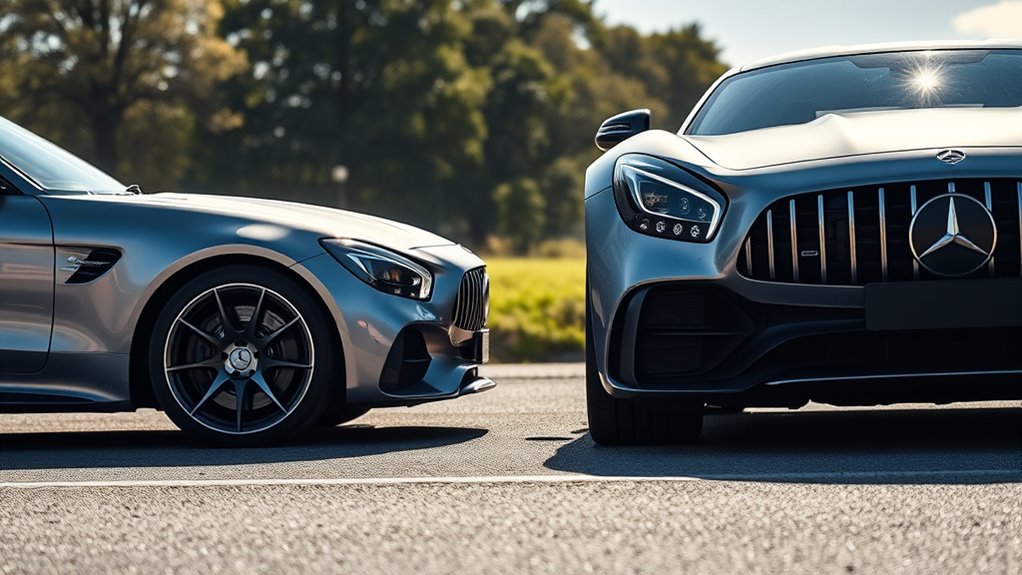
The AMG GT’s active aerodynamic systems exemplify cutting-edge technology designed to maximize performance and stability. The AIRPANEL system features a two-part louver setup that remains closed during normal driving, reducing drag and directing airflow under the car to minimize lift. It opens rapidly when cooling is needed, responding to temperature thresholds within a second. The rear spoiler offers five adjustable positions, automatically deploying at certain speeds to enhance downforce and stability, especially at high speeds. Its integrated design preserves aesthetics when retracted. The active underbody diffuser channels airflow toward the rear, increasing downforce and reducing lift during aggressive cornering. These systems work together to balance cooling, minimize drag, and maintain high-speed stability, ensuring optimal aerodynamic performance across various driving conditions. Modern systems also incorporate noise reduction technology to ensure quieter operation during high-performance driving, demonstrating the integration of aerodynamic principles to optimize vehicle efficiency and handling. Additionally, advancements in vehicle aerodynamics contribute to improved fuel efficiency and reduced emissions by optimizing airflow around the vehicle. Furthermore, innovative materials are being used to enhance the durability and responsiveness of these aerodynamic components, ensuring consistent performance over time. Furthermore, ongoing research into aerodynamic efficiency continues to push the boundaries of automotive performance and sustainability.
Benefits of Aerodynamic Upgrades for Mercedes Vehicles

Aerodynamic upgrades offer Mercedes vehicles significant benefits that improve both performance and efficiency. They reduce drag, boosting fuel economy, especially at higher speeds. Enhanced stability during high-speed driving improves ride quality and safety, while minimized wind noise creates a more comfortable environment. These upgrades also elevate performance in AMG models by improving handling and cornering. Mercedes integrates active aerodynamic components like adjustable spoilers and grille shutters to optimize airflow further. Incorporating vehicle aerodynamics principles can lead to even greater improvements in overall driving dynamics.
Material Choices for Aerodynamic Components
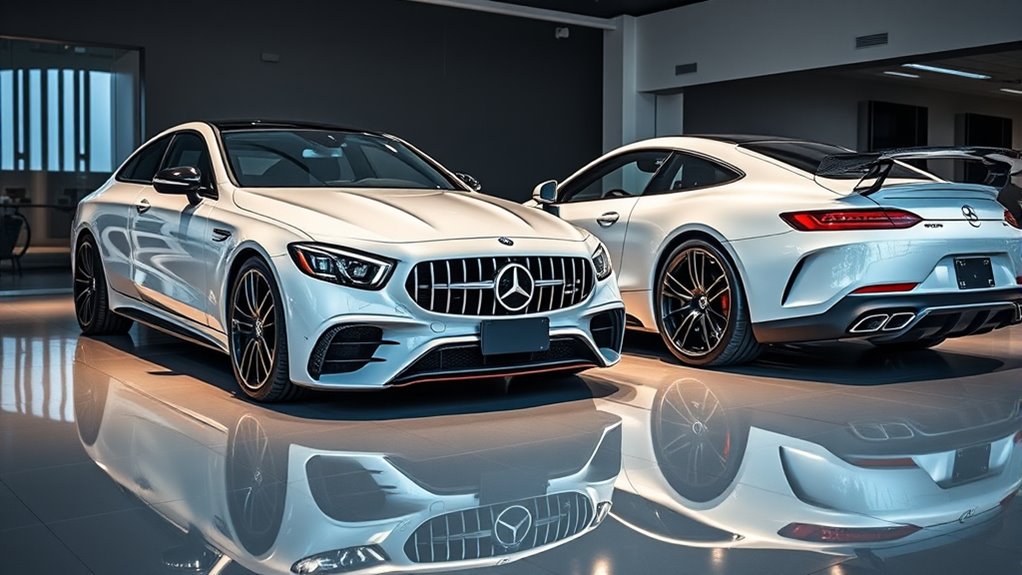
Choosing the right materials for aerodynamic components is essential to balancing performance, durability, and weight savings. Mercedes uses a hybrid bodyshell with over 50% aluminum, reducing weight while maintaining strength. Fiberglass is common in aftermarket kits, offering durability and lightness. For premium upgrades, carbon fiber is favored for its exceptional strength-to-weight ratio. Polymer components connect parts and absorb energy during impacts, enhancing safety. Special foams, like acoustic foams, are integrated into the bodyshell to improve sound insulation without adding significant weight. The materials selected must be thermally stable and impact-resistant to withstand varying temperatures and minor impacts. Additionally, selecting materials that are resistant to environmental factors, such as corrosion or degradation, is crucial for longevity and maintaining aerodynamic integrity material durability. OEMs prioritize a mix of materials to ensure structural integrity and aerodynamics, while aftermarket options often emphasize lightweight and high-strength fibers for performance gains. Proper material selection also involves considering material compatibility to prevent issues such as thermal expansion mismatches or chemical interactions that could compromise the aerodynamic components over time. Incorporating materials with thermal stability ensures they perform reliably under different environmental conditions. Moreover, advancements in composite technologies contribute to developing materials that can better withstand long-term stress and environmental exposure, further enhancing aerodynamic performance material innovation.
Installing Aerodynamic Kits: Key Considerations
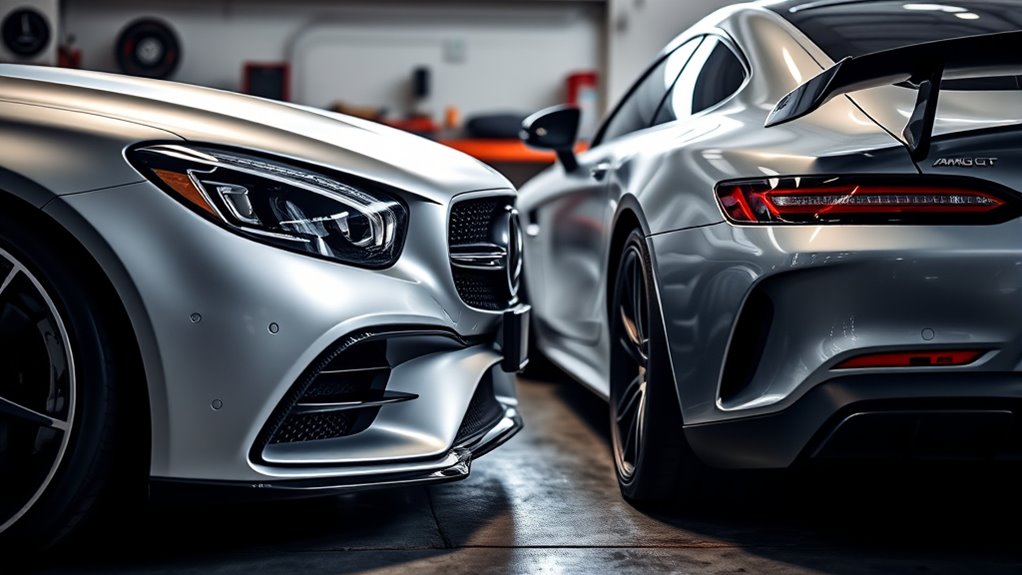
Installing aerodynamic kits on your Mercedes S-Class or AMG GT requires careful planning to guarantee proper fitment and peak performance. First, choose a kit compatible with your vehicle model and aligned with your desired aerodynamic goals. Research reputable manufacturers and read customer reviews to ensure quality and fit. Gather all necessary tools, such as drills, screwdrivers, and wrenches, and prepare a clean, well-lit workspace. Before starting, remove existing parts like bumpers or side skirts, then thoroughly clean and prepare the surfaces. Carefully align new components, using recommended adhesives or fasteners. After installation, check for gaps, rattles, or misalignment. Proper preparation, attention to detail, and patience are vital for a seamless installation, whether you’re doing it yourself or hiring a professional. Additionally, considering the impact of website performance metrics can help you assess the effectiveness of your modifications over time. Ensuring compatibility with aerodynamic principles will also optimize your vehicle’s performance and stability. Incorporating quality materials during installation can further enhance durability and overall results. It is also beneficial to understand how component materials influence the longevity and effectiveness of your aerodynamic modifications, which can be supported by consulting with experts or engaging in regional legal resources to stay compliant with local regulations.
Impact of Aerodynamics on Fuel Efficiency and Performance
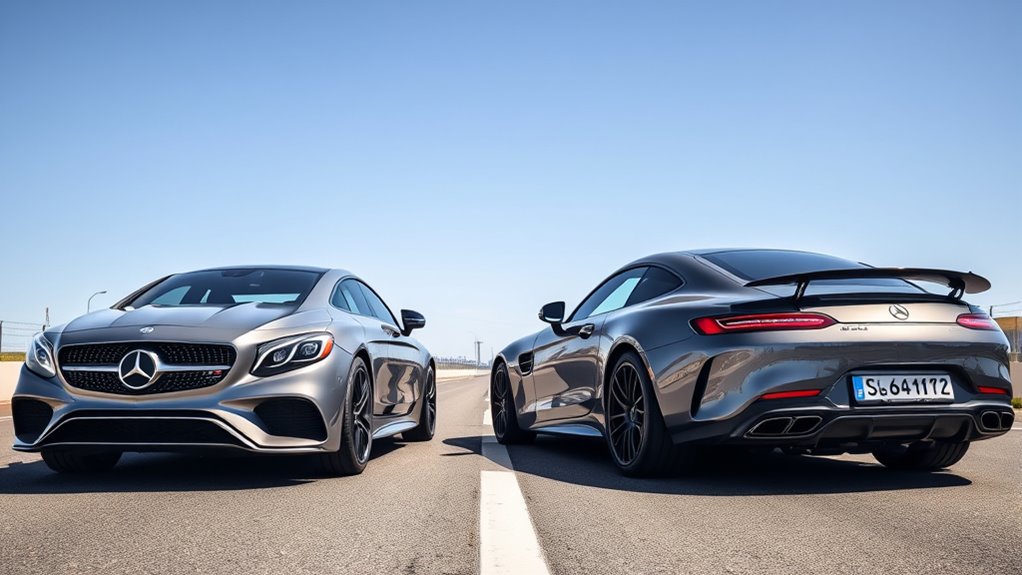
Reducing the drag coefficient (Cd) of your Mercedes considerably boosts fuel efficiency and overall performance. Lower Cd means less wind resistance at high speeds, which saves fuel and improves acceleration. For example, a Cd of 0.22 in the CLA outperforms a Prius with 0.25. Aerodynamics also enhance high-speed stability, vital for models like the AMG GT. Additionally, hybrid systems benefit from optimized airflow, extending electric range and reducing gas reliance. To highlight the importance, consider this table:
| Feature | Effect on Performance | Benefit for Efficiency |
|---|---|---|
| Underbody panels | Smoother airflow | Reduced drag |
| Active grille shutters | Balanced cooling and drag | Improved fuel economy |
| Rear-axle steering | Stability and agility | Indirect aerodynamic optimization |
These features collectively improve both fuel economy and driving dynamics. Optimized airflow plays a crucial role in maximizing aerodynamic benefits and overall vehicle efficiency. Moreover, advancements in aerodynamic design continuously contribute to better vehicle performance and sustainability. Furthermore, employing active aerodynamics allows dynamic adjustment of airflow for optimal performance under different driving conditions. Incorporating advanced materials can also reduce weight, further enhancing aerodynamic efficiency and vehicle handling. Staying informed on regulatory standards ensures that aerodynamic modifications meet safety and environmental requirements.
Customization Options for Mercedes Aerodynamic Features

Mercedes-Benz offers a variety of customization options to enhance your vehicle’s aerodynamics, allowing you to tailor performance and style to your preferences. You can choose from aftermarket kits like the Prior Design PD800s, featuring front bumpers with integrated lip spoilers and fender extensions, or the Lorinser Styling Kit with redesigned bumpers, side skirts, and vents for a sportier look. AMG line packages provide OEM upgrades such as enhanced air intakes, rear diffusers, and side sill panels that improve airflow. You can also add roof and trunk spoilers to reduce lift without increasing drag. For a personalized touch, options like carbon fiber or polyurethane components offer weight savings and durability, giving your Mercedes a unique, performance-focused edge.
- Sleek, aerodynamically optimized spoilers that seamlessly blend with your car’s lines
- Custom vented fenders and side skirts channel airflow effectively around the vehicle
- Lightweight carbon fiber or polyurethane parts enhancing speed and handling
Advances in Wind Tunnel Testing and Simulation Technologies
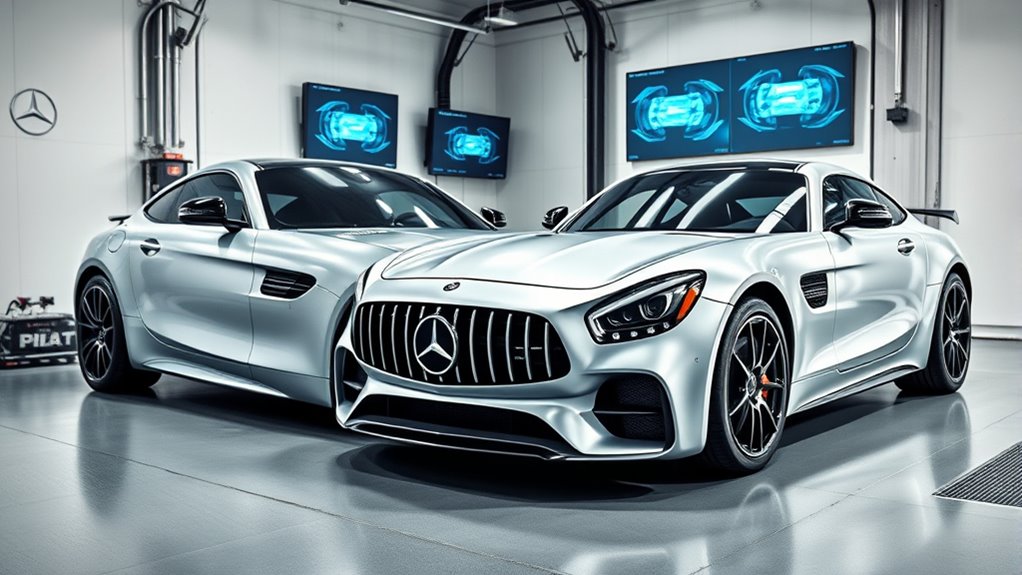
Recent advances in wind tunnel testing and simulation technologies have markedly enhanced vehicle aerodynamics development. You now benefit from models made with 3D printing, which boost precision and reduce lead times. Wind tunnels are integrated closely with Computational Fluid Dynamics (CFD), allowing real-time validation and refinement of designs. This collaboration ensures that aerodynamic improvements translate effectively to real-world performance, efficiency, and noise reduction—especially important for electric and autonomous vehicles. Adaptive control systems further improve testing accuracy by enabling complex scenarios. The industry’s market is growing rapidly, driven by demand for aerodynamic efficiency, with the global market projected to reach USD 1.52 billion by 2030. These technological strides make aerodynamic testing faster, more precise, and more adaptable, directly benefiting vehicle performance and innovation.
Future Trends in Aerodynamic Design for Mercedes Models
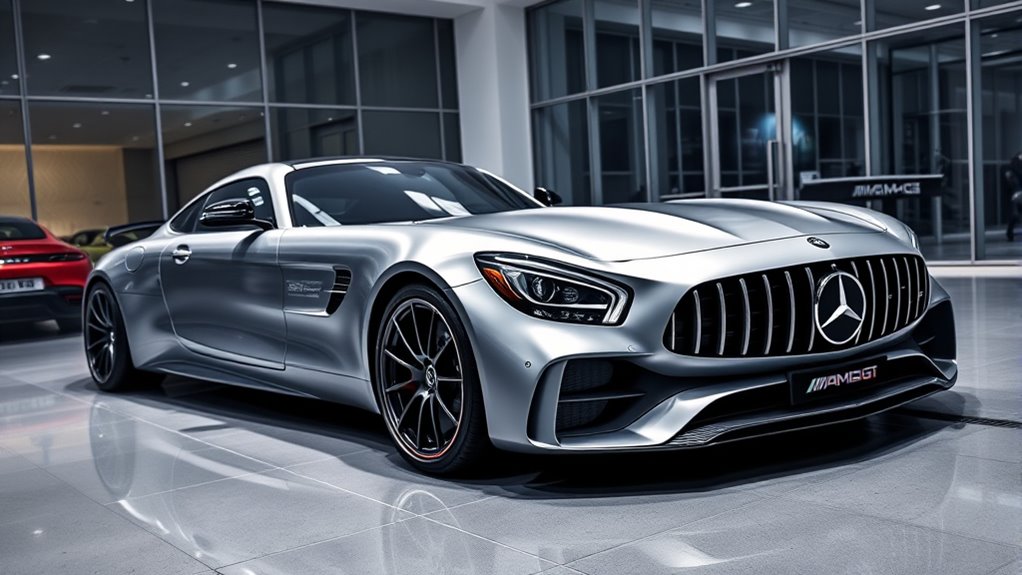
Future aerodynamic designs for Mercedes models are poised to incorporate innovative architectures and materials that markedly enhance efficiency and stability. You’ll see fully closed wheel designs that eliminate brake-cooling vents, reducing drag and turbulence, while active cooling systems operate independently. Smart materials will adapt shape and texture based on driving conditions, with self-healing coatings and lightweight composites reducing weight and drag. AI-driven tools will optimize airflow, predict wind patterns, and refine component shapes during design. Expect the evolution of the single-bow profile, seamlessly blending hood, windshield, and roof to minimize turbulence and increase downforce. For electric vehicles, aerodynamics will focus on reducing frontal area, streamlining underbody channels, and replacing mirrors with cameras. These innovations will transform Mercedes’ aerodynamic efficiency and stability on the road.
Mercedes’ future aerodynamics will feature fully enclosed wheels, smart shape-shifting materials, and seamless single-bow profiles for enhanced efficiency and stability.
- Fully closed wheels with adaptive cooling systems
- Smart, shape-shifting materials for dynamic aerodynamics
- Streamlined, single-bow silhouettes with integrated downforce
Comparing Aerodynamic Enhancements in S-Class and AMG GT
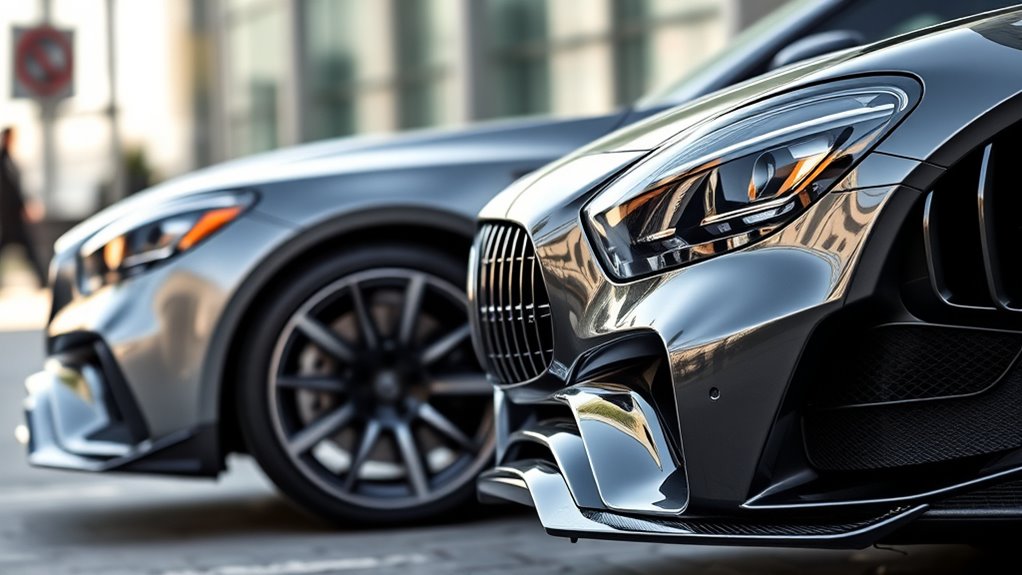
The aerodynamic enhancements in the S-Class and AMG GT reflect their distinct design goals—luxury comfort versus high-performance stability. You’ll notice the S-Class emphasizes low drag with features like optimized underbody panels, aero-wheels, and a smooth front bumper with cooling airflow controls, achieving a low Cd of around 0.22. Its aerodynamic kits, like the PD800s, also incorporate carbon weave components for style and function. Meanwhile, the AMG GT focuses on sporty downforce with spoilers, air dams, and rear diffusers that boost handling at high speeds. Both models undergo extensive wind tunnel testing and computer simulations, but the AMG GT’s lightweight carbon fiber parts prioritize weight reduction and agility. In fundamental terms, the S-Class’s aerodynamics enhance comfort and efficiency, while the AMG GT’s design maximizes performance and stability.
Frequently Asked Questions
How Do Aerodynamic Modifications Affect Mercedes Vehicle Resale Value?
You wonder how aerodynamic modifications impact your vehicle’s resale value. If you add high-quality, desirable upgrades like spoilers or carbon fiber parts, they can boost appeal to performance buyers and potentially increase value. However, overly aggressive or non-standard mods might turn off some buyers, lowering resale prospects. Keeping modifications well-maintained and reversible, and restoring original parts, can help maximize your car’s resale value regardless of your upgrades.
Are There Specific Maintenance Routines for Aerodynamic Kits?
Did you know that regular maintenance can extend the lifespan of aerodynamic kits by up to 30%? You should clean your aerodynamic components with mild shampoos and soft microfiber cloths, avoiding harsh chemicals. Rinse thoroughly, dry with a lint-free cloth, and inspect frequently for damage. Follow manufacturer guidelines for material-specific care, and consider protective coatings or waxes to keep your aerodynamic kits in top shape and guarantee superior performance.
Can Aerodynamics Improve Ride Comfort Alongside Performance?
Yes, aerodynamics can improve your ride comfort along with performance. By managing airflow better, your vehicle becomes more stable at high speeds, reducing turbulence and noise. This stability lessens body roll and vibrations, making your drive smoother. Additionally, enhanced downforce keeps your car grounded, improving handling and comfort during turns. Overall, aerodynamic improvements create a more controlled, comfortable ride while boosting your vehicle’s performance and efficiency.
Do Aftermarket Kits Void Mercedes Warranty Coverage?
You want to know if aftermarket kits void your Mercedes warranty. Generally, cosmetic modifications like aerodynamic kits don’t automatically void your coverage. However, if the kit causes or contributes to a failure, the manufacturer might deny your claim. Keep detailed records of your modifications, and confirm they’re installed properly. Remember, warranty issues depend on whether the aftermarket part directly affects the vehicle’s systems or causes damage.
How Do Aerodynamics Influence Noise Levels Inside the Vehicle?
Imagine the car’s airflow as a gentle river flowing smoothly around rocks; when aerodynamics are optimized, it whispers quietly inside. You’ll notice less wind noise because streamlined designs guide air seamlessly, reducing turbulence. Active systems and aerodynamic features act as barriers, shielding you from external sounds. This creates a tranquil cabin where noise diminishes, allowing you to enjoy a peaceful, refined driving experience—your vehicle becomes a sanctuary of serenity amidst the outside world.
Conclusion
By upgrading your Mercedes with aerodynamic enhancements, you can improve both performance and style. Did you know that aerodynamic modifications can increase fuel efficiency by up to 10%? Whether you choose a sleek kit for your S-Class or active systems for your AMG GT, these features help you enjoy a smoother, faster drive. Embrace the future of car design and make your Mercedes truly stand out on the road.





